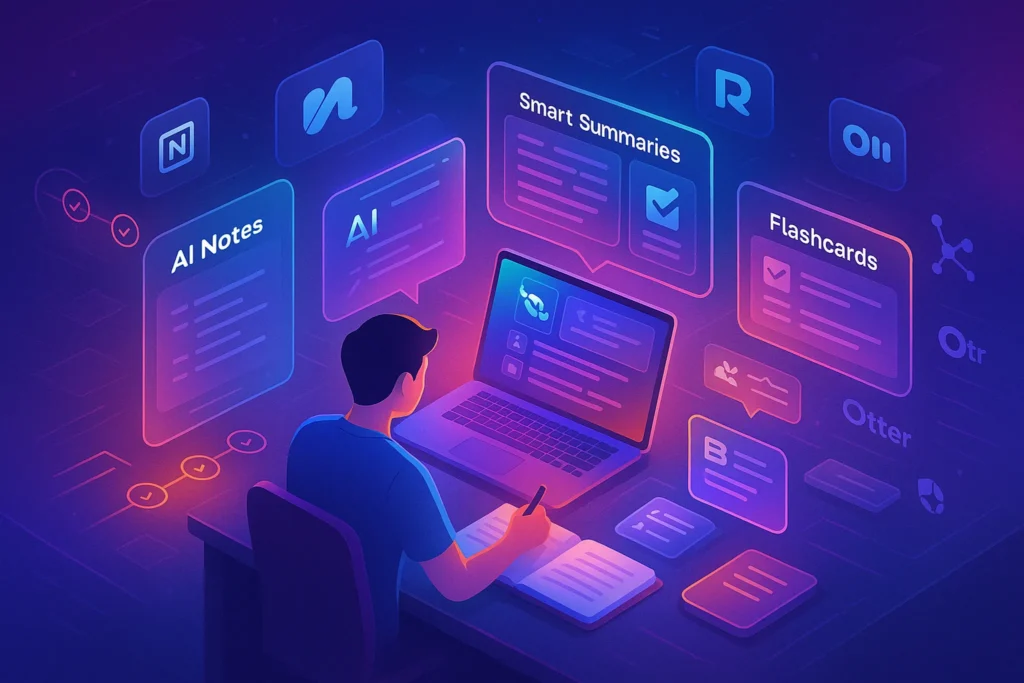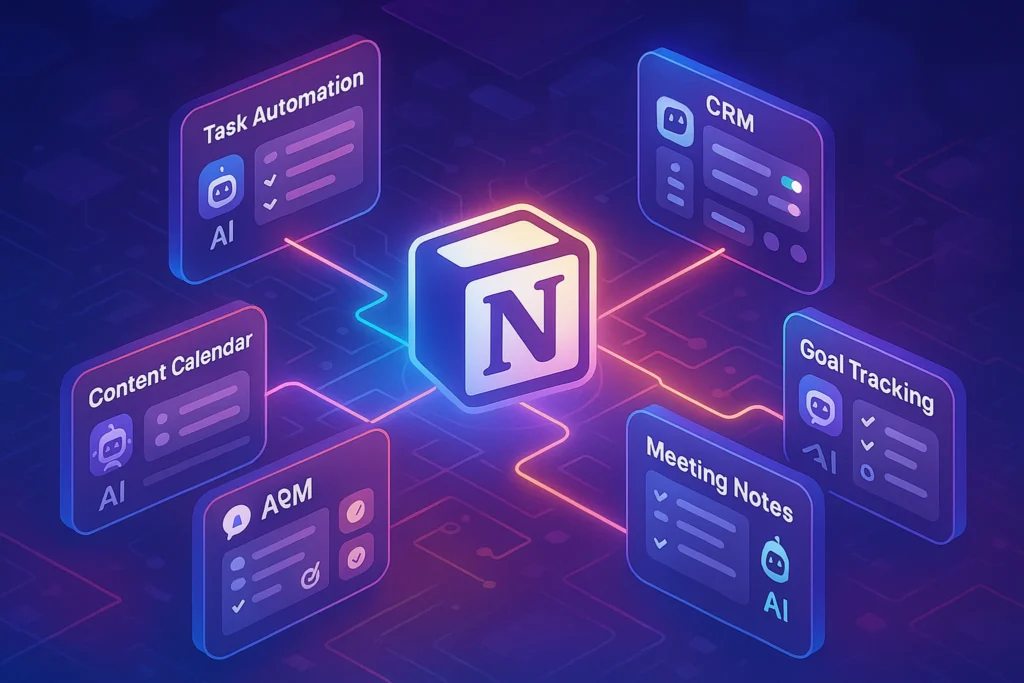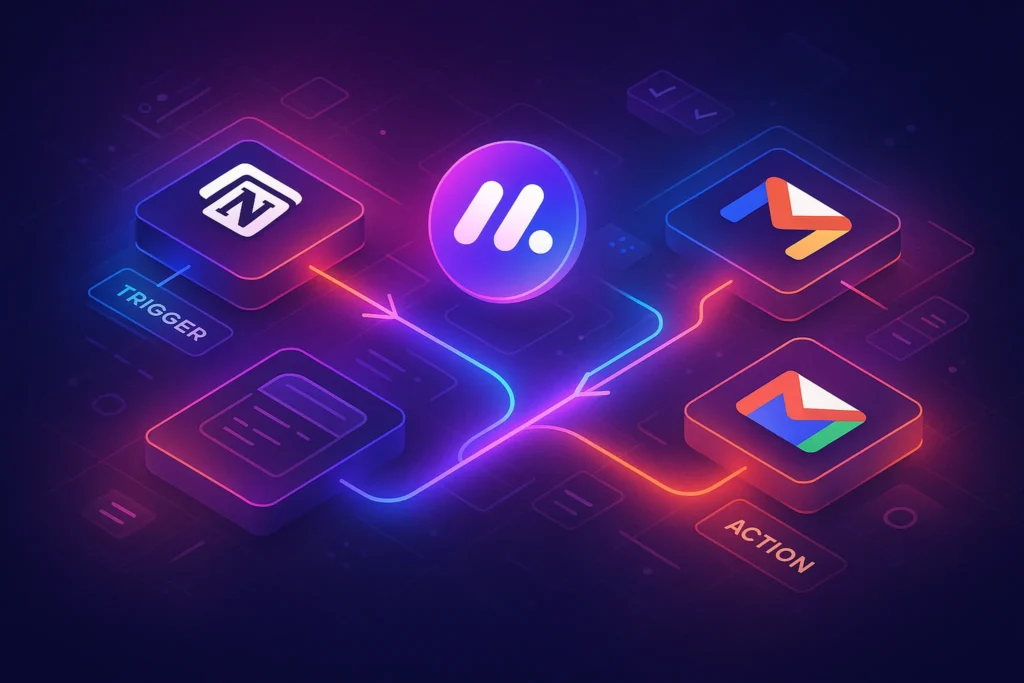-This post may contain affiliate links. If you click on one and make a purchase, I may earn a small commission at no extra cost to you.-
🚀 Introduction – Study Smarter, Not Harder
Note-taking is more than just writing down words—it’s the foundation of learning. Students often struggle to keep up with fast-paced lectures, organize scattered ideas, or review sessions for exams. Manual transcription eats into study time and often leads to missed insights.
Welcome to 2025, where AI-powered note-taking apps are game-changers:
-
Live transcription for hands-free capture
-
Auto-summarization to highlight key points
-
Organized knowledge bases for easy review
-
Voice-based capture so you never miss a moment
These apps free students from chasing words, letting them focus on comprehension and retention. If you’ve tried automating your meeting notes before, check out our guide: How to Automate Meeting Notes with AI. Now, let’s find the best tool for your classroom, dorm, or study space.
📝 The Best AI Note‑Taking Apps for Students
If you’re still unsure whether Notion or Evernote aligns better with your long-term workflow, it might help to zoom out and rethink your entire note-taking system. We explored the concept of building a “Second Brain” in our Ultimate Guide to Building a Digital Second Brain, where we dive into foundational strategies for knowledge capture, task linking, and idea retrieval—regardless of the platform. Understanding this bigger picture could shift the way you evaluate these tools altogether.
Here are our top picks, tailored to different academic styles and learning environments:
1. 🎓 Otter.ai – Best Overall for Lecture Capture
Why It Matters: Captures entire lectures in real-time, accurate transcription with speaker identification, and summary capabilities—ideal for note accuracy and post-class review.
Real Student Use Case: A student recording back-to-back lectures uploads them to Otter, then reviews tagged key points during study sessions.
Key Features:
-
Live captions during in-person classes or Zoom lectures
-
Smart Summary for action items
-
Custom vocabulary (e.g., repeating technical terms)
Free Plan: 600 min/month
Verdict: Best for comprehensive classroom capture
2. ✍️ Notion AI – Best for Study Organization
Why It Matters: Notion’s AI helps structure chaotic lecture notes into organized databases, flashcards, and custom study templates.
Real Student Use Case: A biology student uses Notion AI to convert raw class notes into summary tables and flashcard decks.
Key Features:
-
Multi-format notes (text, tables, flashcards)
-
Auto-summarize and extract action items
-
Integrated with spaced-repeat tools via API
Free Plan: Included with Notion
Verdict: Best for long-term study planning
3. 🖋 Sonix – Best for Multilingual Lectures
Why It Matters: Supports 30+ languages—great for international students or multicultural classrooms.
Real Student Use Case: A linguistics student records bilingual lectures and automatically translates transcripts.
Key Features:
-
Timestamped transcription, translation support
-
Downloadable transcripts in multiple formats
-
Browser-based editing
Free Plan: Trial available
Verdict: Best for global note-taking
4. ✍️ Microsoft OneNote + Dictate – Best Built-In Option
Why It Matters: Combines note-taking app and speech-to-text within Microsoft ecosystem—convenient for Windows users.
Real Student Use Case: A computer science student records code demonstrations and architecture discussions directly in OneNote.
Key Features:
-
Built-in voice-to-text Dictation
-
Organizational features: sections, pages, drawing
-
Syncs with Office suite
Free Plan: Included with Office 365 subscription
Verdict: Best for tight Office users
5. ✍️ Evernote + AI Assistant – Best for Handwritten Notes
Why It Matters: Combines handwriting capture (via stylus or scan) with AI transcription and organization—ideal for tablet note-taking.
Real Student Use Case: An art student writes notes on a tablet/sketchpad, then searches text instantly within Evernote.
Key Features:
-
Handwriting recognition and OCR
-
Audio recording embedding
-
Intelligent tagging
Free Plan: Two synchronizing devices
Verdict: Best for digital handwriting users
6. 🔍 Echo by MEM – Best for Knowledge Discovery
Why It Matters: This AI note assistant surfaces insights and connections from your study notes—helpful during exam prep.
Real Student Use Case: A philosophy major uploads lecture notes to Echo; it flags related concepts and builds flashcards.
Key Features:
-
AI-generated flashcards/questions
-
Linked knowledge map
-
Searchable note archive
Free Plan: Basic knowledge graph free
Verdict: Best for concept building
7. 🌐 Fireflies.ai – Best for Group Study Sessions
Why It Matters: Records, transcribes, and highlights virtual group study calls—ideal for collaborative projects.
Real Student Use Case: Semester-long project meetings between remote team members synced automatically in Fireflies.
Key Features:
-
Speaker labeling, key phrase markers
-
Export to Notion, Slack, Email
-
Team collaboration
Free Plan: 3 meetings/month
Verdict: Best for group academic projects
📊 Quick Comparison Table
| Tool | Best Feature | Free Plan | Ideal User |
|---|---|---|---|
| Otter.ai | Live transcription | ✅ 600 min/month | All students |
| Notion AI | Study organization | ✅ Included | Project-heavy learners |
| Sonix | Multilingual support | ✅ Trial | International students |
| OneNote + Dictate | Office integration | ❌ Office 365 | MS Office users |
| Evernote + AI | Handwritten capture | ✅ 2 devices | Creative note-takers |
| Echo by MEM | Flashcards & concept map | ✅ Basic free | Concept-focused learners |
| Fireflies.ai | Group meeting capture | ✅ 3 meetings/month | Project teams |
🧠 Why Choose an AI Note App?
-
Accuracy: Capture every lecture word-for-word, even in fast-paced classes
-
Efficiency: Focus on discussions—later use AI to generate summaries and flashcards
-
Organization: Sort notes by class, exam, or date in seconds
-
Accessibility: Ideal for students with hearing or learning challenges
-
Shareability: Collaborate with classmates by sharing tagged notes
While AI-powered apps are changing how students take notes, classic platforms like Notion and Evernote still hold strong in 2025—especially for structured, long-term organization. Our recent Notion vs. Evernote comparison guide digs into what makes each one unique and which might better suit your academic style, especially when paired with AI-enhanced workflows.
🧩 Smart Tips to Maximize Your AI Note-Taking
-
Use Lecture Templates
Create and reuse structured templates (e.g., “Key Concepts – Examples – Questions – Action Items”) in apps like Notion or OneNote. When AI fills in details, they’re already organized for study and review. -
Capture In-Person Audio with Quality
Use your phone’s voice memo or a clip-on mic during live lectures. Upload this to Otter or Sonix afterward—the cleaner the audio, the more accurate the transcription. -
Train Custom Vocabulary
In Otter.ai and Sonix, add course-specific terms (e.g., protein names, historical references) to improve accuracy. This is especially useful for technical or niche subjects. -
Edit and Annotate
Always review transcripts soon after class. Add context notes, highlight crucial parts, and embed questions or reminders for exam prep. -
Generate Flashcards Automatically
Use Notion AI or Echo by MEM to turn your notes into flashcards. Prompt AI: “Create 5 flashcards from this summary.” Now you’ve built study tools in minutes. -
Leverage Collaboration Tools
Apps like Fireflies and Otter share meeting notes with classmates automatically. Instead of emailing files, classmates see edits and updates in real time. -
Sync Across Devices
Make sure your notes sync across phone, tablet, and laptop. Apps like Evernote and Notion offer seamless cross-device functionality—never miss a thought.
🌟 How to Choose the Right Tool for You
| Student Type | Best Tool(s) | Why It Works |
|---|---|---|
| Lecture-focused | Otter.ai + Sonix | Real-time capture + multilingual support |
| Note organization fan | Notion AI + Echo | Structured summaries + flashcards |
| Handwriting digitalizer | Evernote + AI | OCR + voice embedding for digital handwritten notes |
| Group project teams | Fireflies.ai | Shared annotated meeting records |
| Microsoft ecosystem users | OneNote + Office Dictate | Built-in tools + Office integration |
🌍 Use Case Scenarios
-
Undergrad Biology Student
Records lectures in Otter.ai. After class, adds images and diagrams to notes. Exports summary to Notion for exam study. -
Language Major
Uses Sonix to transcribe bilingual classroom discussions. Edits transcript, exports to study app for language drills. -
Group Project Crew
Three teammates study remotely. They run Fireflies.ai during group meetings. Transcripts and key points sync in Notion so no one misses what’s said.
❓ FAQ
1. What is the best AI note-taking app for lectures?
📌 Otter.ai stands out for lecture settings. Its real-time transcription and Smart Summaries help students capture every detail and quickly review key points after class.
2. Can I use AI note-taking apps for handwritten notes?
Yes! Evernote supports OCR (Optical Character Recognition) for handwritten notes, and integrates with styluses and tablets. It can even search your handwriting.
3. Do AI note-taking apps work offline?
Most require an internet connection for real-time AI features like transcription or summarization. However, apps like Notion and OneNote offer partial offline functionality.
4. Are AI note apps safe for storing personal notes and lectures?
Generally, yes — most tools use encryption and secure servers. However, you should review each tool’s privacy policy, especially if recording classes with other students or professors involved.
5. Which is best for international or multilingual students?
Sonix supports over 30 languages and can transcribe and translate lectures. It’s ideal for bilingual or non-native English speakers.
6. Do these tools integrate with learning platforms like Google Classroom or Canvas?
Some do, like Notion and Otter.ai through Zapier or direct APIs. Check the integration settings or third-party apps for automation.
7. Can AI tools summarize long study materials?
Yes, Notion AI and Echo by MEM are excellent for summarizing documents, lecture transcripts, and converting them into flashcards or actionable study guides.
💬 Would You Bite?
Tell us: What’s your current AI-notetaking tool, and how has it improved your learning?
We’d love to hear your stories! 👇



